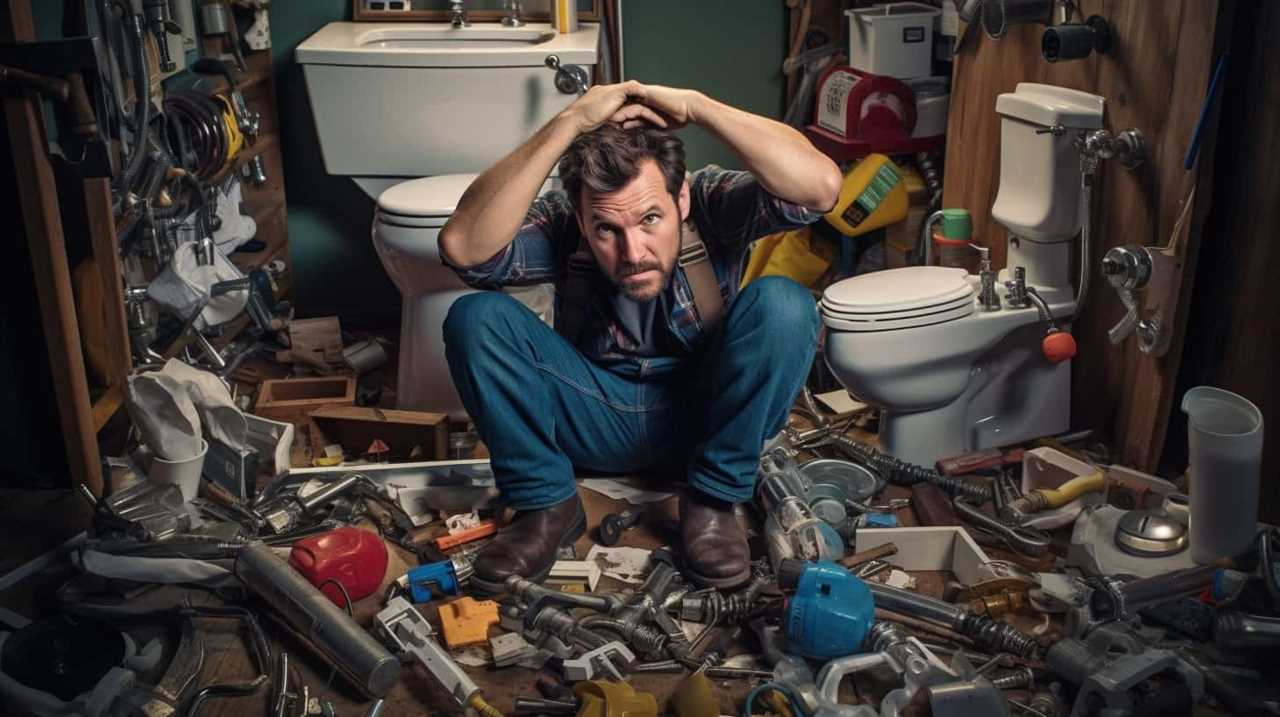Do you wonder if toilets can unclog themselves?
In this article, we will explore the common causes of toilet clogs, signs to look out for, and if there is any truth to the notion of a self-unclogging toilet.
We will also provide you with expert tips on preventing clogs and steps to take when faced with a stubborn blockage.
Prepare to master the mysteries of toilet unclogging!

Key Takeaways
- Toilet clogs cannot be self-unclogged.
- Tools like plungers, toilet augers, or chemical drain cleaners are needed to effectively unclog a toilet.
- Some clogs may loosen or clear on their own, but it’s not reliable.
- Toilets are designed to flush waste, not to remove clogs.
Common Causes of Toilet Clogs
Sometimes, we often encounter toilet clogs due to common causes that can easily be avoided. Toilet clogs can be a frustrating and unpleasant experience, but with proper toilet clog prevention and remedies, they can be prevented or quickly resolved.
One common cause of toilet clogs is flushing excessive amounts of toilet paper or other non-flushable items down the toilet. To prevent this, it’s important to educate ourselves and our family members about what can and can’t be flushed.
Additionally, a lack of regular maintenance can lead to toilet clogs. Regularly cleaning and inspecting the toilet can help identify any potential issues before they become major problems.
If a clog does occur, there are simple toilet clog remedies such as using a plunger or a plumbing snake to clear the blockage. By following these simple steps, we can avoid unnecessary toilet clogs and maintain a smoothly running toilet.

Signs That Your Toilet May Be Clogged
To determine if your toilet is clogged, we can look for specific signs that indicate a blockage. These signs include:
| Signs | Description | Possible Cause |
|---|---|---|
| Slow Drainage | Water takes longer than usual to drain from the bowl, indicating a partial clog. | Accumulation of debris or foreign objects in the pipes. |
| Overflowing | If the water level rises significantly when you flush, it suggests a complete blockage. | Excessive toilet paper or a solid object obstructing the toilet trap. |
| Gurgling Sounds | Unusual gurgling noises coming from the pipes when you flush could indicate a clog. | Air trapped in the pipes due to a blockage. |
| Foul Odor | A persistent, unpleasant smell emanating from the toilet may indicate a clog. | Decomposing waste trapped in the pipes. |
If you notice any of these signs, it’s essential to address the clog promptly to prevent further issues. In the next section, we will explore whether the toilet can unclog itself and discuss possible solutions for DIY toilet unclogging.
Can the Toilet Unclog Itself
The question arises: Can the toilet unclog itself?
There are numerous myths about toilet unclogging, including the idea that toilets have the ability to self-unclog. However, this is simply not true.

A toilet clog occurs when there’s a blockage in the pipes that prevents water and waste from flowing freely. While some clogs may loosen or clear on their own over time, this isn’t a reliable method of unclogging a toilet. Toilets are designed to flush waste, not to remove clogs.
In order to effectively unclog a toilet, it’s necessary to use a plunger, a toilet auger, or a chemical drain cleaner. These tools are specifically designed to dislodge and remove clogs, ensuring that the toilet functions properly once again.
How to Prevent Toilet Clogs
To avoid future toilet clogs, we can take proactive measures by practicing good flushing habits and being mindful of what we flush down the toilet. Toilet clog prevention begins with understanding what shouldn’t be flushed.
Items such as hygiene products, baby wipes, paper towels, and food waste can easily cause blockages in the pipes. It’s important to only flush toilet paper and waste.

Additionally, maintaining good flushing habits is crucial. Flushing multiple times for large amounts of waste or using excessive amounts of toilet paper can overload the system and lead to clogs.
Regular maintenance, such as using enzymatic cleaners and conducting periodic inspections, can also help prevent clogging.
By following these DIY toilet unclogging techniques, we can reduce the risk of clogs and ensure a properly functioning toilet.
Now, let’s explore the steps to take when your toilet is clogged.

Steps to Take When Your Toilet Is Clogged
When dealing with a clogged toilet, we can take immediate action to resolve the issue. The first step is to assess the severity of the clog. If it’s a minor clog, we can attempt to unclog it ourselves using a plunger. Here’s how to use a plunger effectively:
| Step | Instructions |
|---|---|
| 1 | Place the plunger over the drain hole, ensuring a tight seal. |
| 2 | Push down firmly and then pull up forcefully, creating suction. |
| 3 | Repeat this plunging motion several times until the water starts to drain. |
| 4 | Flush the toilet to check if the clog has been cleared. |
However, if the clog persists or if it’s a major clog, it’s time to call a professional plumber. They have the expertise and tools to handle more complex clogs and prevent further damage to the plumbing system. Knowing when to call a professional plumber is crucial to avoiding costly repairs and ensuring the problem is resolved efficiently.
Frequently Asked Questions
How Can I Tell if My Toilet Is Clogged?
To determine if a toilet is clogged, look for signs such as slow drainage, water rising to the rim, or gurgling sounds. If unclogging without a plunger is desired, try using hot water, dish soap, or a toilet auger.
How Often Should I Check for Clogs in My Toilet?
Toilet maintenance is crucial to prevent clogs. Regularly checking for signs of a clogged toilet is recommended. Our research shows that it’s best to check for clogs at least once a month to avoid any potential issues.

Can Using Too Much Toilet Paper Cause a Clog?
Using excessive toilet paper can cause clogs in toilets. To prevent this, consider toilet paper alternatives like bidets or wet wipes. Understanding why toilet paper clogs toilets is crucial for maintaining a functional plumbing system.
Are There Any DIY Methods to Unclog a Toilet Without Using a Plunger?
Toilet clog prevention and natural remedies for unclogging toilets are essential knowledge. We can explore DIY methods to unclog a toilet without a plunger. Let’s discuss effective techniques and solutions.
Is It Possible to Prevent Toilet Clogs Completely?
Preventing toilet clogs completely is challenging. Common causes include excessive toilet paper usage and flushing inappropriate items. While it is not possible for the toilet to unclog itself, regular maintenance and proper usage can minimize clogs.
Conclusion
In conclusion, it’s important to remember that toilets can’t unclog themselves. Understanding the common causes of toilet clogs can help you take preventative measures to avoid this inconvenience.

If your toilet does become clogged, it’s essential to take immediate action to resolve the issue. By following the proper steps and utilizing the right tools, you can effectively unclog your toilet and prevent further problems.
Stay informed and proactive to maintain a clean and functional bathroom.










